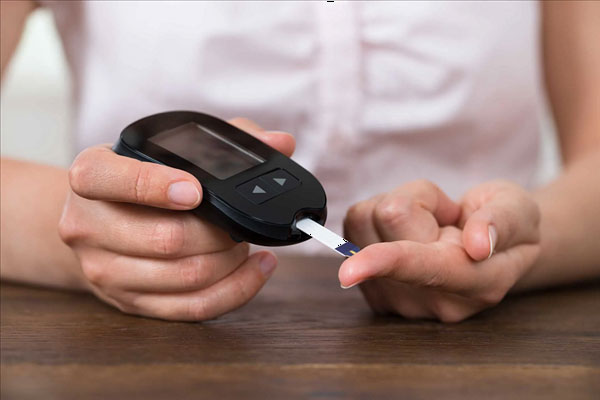The world's first sweat glucose meter
Penn State University researchers (USA) have developed a device that monitors blood sugar through sweat. This is considered the world's first wearable, non-invasive blood glucose monitoring device.
Detects low glucose levels in sweat

A common blood glucose meter on the market.
Currently, non-invasive blood glucose monitoring devices are not commercially available in the US, so people with diabetes must take a blood sample or use a sensor attached to the skin to measure their blood sugar. surname. Thanks to the new device, non-invasive blood glucose monitoring could become the norm.
Lead researcher is Professor Huanyu Larry Cheng, Department of Engineering Science and Mechanics of Pennsylvania State University. They published details of a low-cost, non-invasive sensor that can detect glucose in sweat using sensors and bioelectronics.
The researchers first built the device using laser induced graphene (LIG). This is a material consisting of atom-thick layers of carbon of various shapes. With its high conductivity and fabrication time within seconds, LIG seems to be an ideal framework for sensing equipment.
However, Professor Cheng says there is a challenge here as the LIG is completely insensitive to glucose, so it is necessary to place a glucose-sensitive material in the LIG.
According to Cheng, the team chose nickel because of its strong sensitivity to glucose, and combined it with gold to reduce the risk of possible allergies. The researchers hypothesized that a LIG equipped with a nickel-gold alloy would be able to detect low concentrations of glucose in sweat on the surface of the skin.
Materials that are sensitive to glucose are a priority. Sweat represents a significantly lower concentration of glucose compared to blood. But according to Professor Cheng, there is a strong correlation between sweat and blood.
Although the concentration of glucose in sweat is about 100 times lower than the concentration in blood, the team's device is sensitive enough to accurately measure the amount of glucose in sweat and reflect this concentration in the blood.
The sensitivity of the nickel-gold alloy allows Professor Cheng's team to rule out enzymes commonly used to measure sugar in more invasive commercial devices. However, these enzymes can be degraded rapidly with time and changes in temperature.
An enzyme sensor must be kept at a certain temperature and pH, nor can it be kept for long, Professor Cheng said. Meanwhile, the enzyme-free glucose sensor has the advantage of stable performance and glucose sensitivity regardless of the above changes.
Device improvements to extend the application

The non-invasive blood glucose meter was created by Pennsylvania State University researchers.
However, the non-enzymatic sensor requires an alkaline solution, so it is easy to damage the skin and limit the wearability of the device. To overcome this problem, Professor Cheng and colleagues attached a microfluidic chamber (microfluidic - a technique involving controlling the flow of liquid inside small volume channels) to the LIG alloy.
The chamber is smaller than previously developed profiles for increased strength and porosity, allowing a range of movements such as stretching or crushing. It is connected to the part that puts the sweat into the solution without letting the solution come into contact with the skin.
The basic solution interacts with the glucose molecules to produce a compound that reacts with a nickel-gold alloy. This response triggers an electrical signal, which indicates the concentration of glucose in the sweat.
According to Professor Cheng, with such a small lye chamber, the device is flexible enough to maintain a safe attachment to the human body.
In one test, researchers used a skin-safe adhesive to attach the reusable device to a person's arm for 1 hour and 3 hours after a meal. Subjects performed a short workout that produced a sweat before each glucose measurement.
Minutes after the sweat was collected, the researchers found that the glucose levels detected had decreased from the first measurement to the next. The blood glucose measurements from the above device were then reconfirmed with a commercially available blood glucose meter.
Professor Cheng and team plan to refine the device for future applications, including improving the way patients and doctors can use the sensor to measure blood sugar spikes or monitor it to identify determine treatment, such as insulin administration.
They also intend to refine and extend this platform to track other biomarkers that may be found in sweat.
"The researchers want to work with doctors and other healthcare providers to see how this technology can be applied to daily patient monitoring. This glucose sensor serves as an example. It is a good example that the ability to detect biomarkers in sweat at extremely low concentrations can be improved" - Prof. Huanyu Cheng.
- Blood glucose meter, health care therapy
- With sweat, you can know a lot about health and crime
- The device detects health abnormalities through ... sweat
- Blood glucose meter for people with diabetes
- Use microwave to replace traditional blood glucose meter
- 9 think less people know about sweat
- When should I put glucose into my body?
- Introducing a new way to measure blood sugar
- Why do some people sweat more than others?
- Sweating causes the foot?
- Discovering bees 'licking sweat to live'
- Harnessing power from sweat
 13 causes of non-itchy rash
13 causes of non-itchy rash How the mouse with human ears changed the world?
How the mouse with human ears changed the world? The truth about 'fried rice syndrome!
The truth about 'fried rice syndrome! What is dental implant?
What is dental implant?